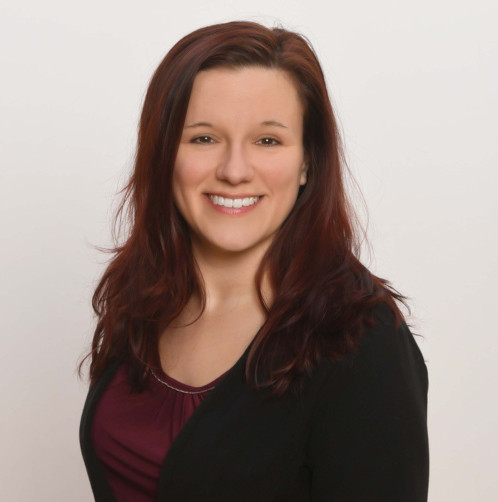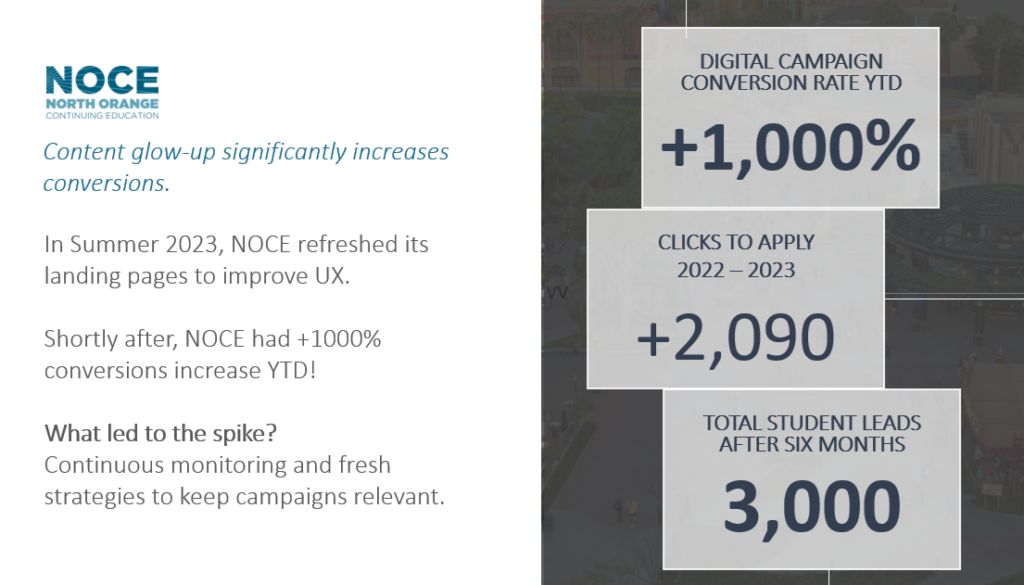
Mariah Tang
November 14, 2024
In the world of higher education marketing, Continuing Education (CE) is one of the more challenging verticals to promote, for several reasons.
Because of its breadth of programming—everything from certified nursing assistant (CNA courses) to basket weaving—CE courses are managed by multiple teams from several departments. That means disparate stakeholders with varied levels of time, budget, and enthusiasm, and lots of opinions about how to market and who should be the decision-makers.
Because of this diversity, some adult learners are looking for a class to start a hobby while others are giving up something important—family time, overtime at work, the comfort of the status quo—to plan for their careers.
The CE audience is special, and institutions can’t rely on one-size-fits-all or generic messaging to reach them.
Each campaign must be unique in tone and angles, with shared design elements. To successfully market for CE, institutions need a thorough understanding of who their niche audience members are outside of school, the challenges they face, and strategies to help them make the trade-off of time/comfort to choose your institution.
At Content Marketing World and NCMPR District 6 2024, I joined Jennifer Perez, Director of Campus Communications at North Orange Continuing Education (NOCE), to discuss how to create on-point, engaging messaging that connects with underserved adult learners. We focused on three specific tactics to promote upskilling and enrichment programs—and deliver the help and information this unique audience needs.
Someone interested in CNA is probably not interested in a class about chair yoga for seniors (at least not at this moment). So, it makes sense that you wouldn’t try to lump both programs into one ad.
But we see this misstep time and again. Limited budgets and low understanding of audience needs can lead institutions to generic messaging that spreads itself too thin.
A better strategy, Perez said, is to tap into the emotional journey of the prospective adult learner:
Here is an example of a good ad from NOCE:

Just like an ad shouldn’t be generalized, nor should the page to which you are sending that paid traffic. Even the best ads won’t convert to expectations if the campaign landing page (CLP) experience is vague or confusing.
With limited budgets or time comes the temptation to include *all the details* in the CLP. But doing so will overwhelm a busy adult learner. On-page busyness and unclear calls-to-action will make the conversion steps unclear, resulting in page abandonment.
Instead, Perez recommends choosing one call-to-action per ad and landing page. Think of the call-to-action as the visitor’s “to-do” or next natural step. Give them one thing to do—repeated as necessary on the page—and the chances it will get done will increase.
NOCE worked with Stamats to revise a series of CE campaign landing pages for a more streamlined user experience. The result? A 1,000% increase in conversions and more than 3,000 student leads in six months.

After the visitor provides their information or completes the conversion step, make sure the follow-up is validating, quick, and sincere. Provide a thank-you page with next steps, along with a follow-up email or text to explain next steps.
For even better results, take time to mystery shop your campaign experience. Many clients believe their system is working as expected, only to find that emails weren’t being sent or calls weren’t being made. Stamats mystery shopping answers questions such as:
Related reading: Reimagining the Marketing Funnel: Time for a New Model
Adult learners want to understand the value of their investment before diving in. And throughout the academic experience, they’ll need answers to specific questions about their training, future career, and how to manage the work-life-school balance.
NOCE relies on real-time insights from students, staff, and faculty to understand the questions learners are asking. They send surveys and host an in-person forum each fall to get feedback on everything from their curriculum to their social services, such as the food pantry and tuition assistance.
Stamats and NOCE complement that invaluable feedback with digital tools that surface search queries real people are typing into social media and search engines. Some of these tools include social listening platforms, Looker Studio organic search query dashboards, and query patterning sites such as Google Trends.
Using these insights, create pointed articles, videos, postcards, and infographics that go deep to answer specific questions. Insert details about how your institution helps throughout this process.
Here’s an example outline of what to include in a story about “how to become a CNA”:
Take this strategy a step further to create a knowledge hub of content that focuses on niche aspects of the main topic. Your stories could answer FAQs about welding, and you could profile alumni who completed the program and now excel in their career.
Throughout the story, sprinkle in links to supplemental information. This is where we can bend on our CTA rule—while there should be one primary call-to-action, content marketing is the art and science of balancing the next steps of visitors at multiple journey points. Often, users are coming in from search or social media, whereas ads drive users from focused micromoments of interest. So, the story should include supplemental calls-to-action for a strategic range of next steps.
And don’t forget the platform—think about where your adult learner audience spends the most time. Most use a smartphone for digital communication, so text messaging, email, and social media are important channels for CE marketing. Stamats and NOCE have also seen success with radio spots, native ads (placing blog content on relevant websites your audience uses), and good old-fashioned mailers.
Listen: SEO is not a service. It’s a way of life.
We love Continuing Ed marketing because it is true to the soul and spirit of the goals of education—tapping into your talents to make the world a better place and providing a better life for yourself and your family.
When you are ready to launch your CE, email me or message me on LinkedIn. Stamats will help you craft the right messaging and marketing plan to reach adult learners with the training and enrichment programs they need to thrive.